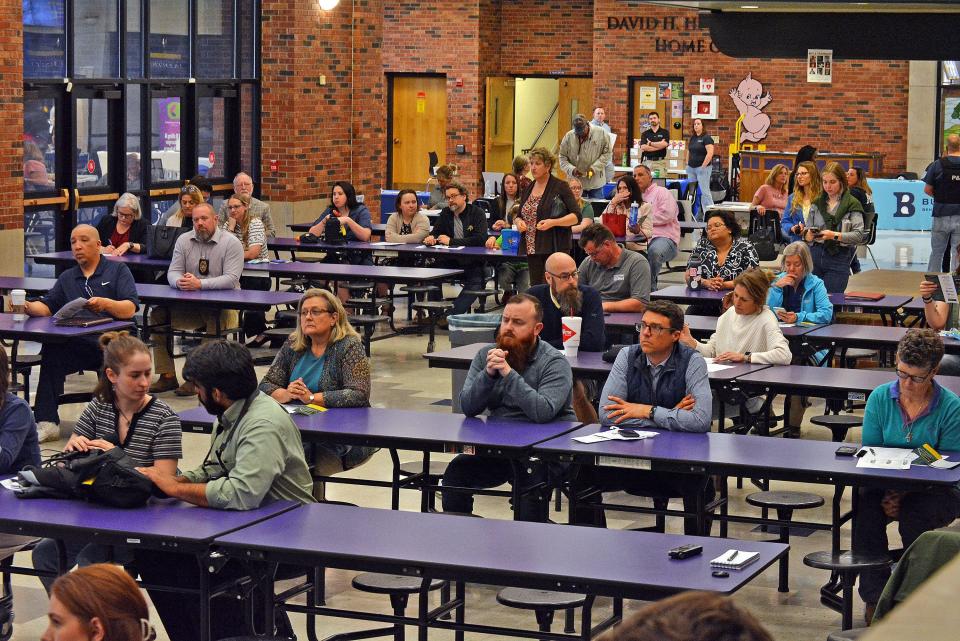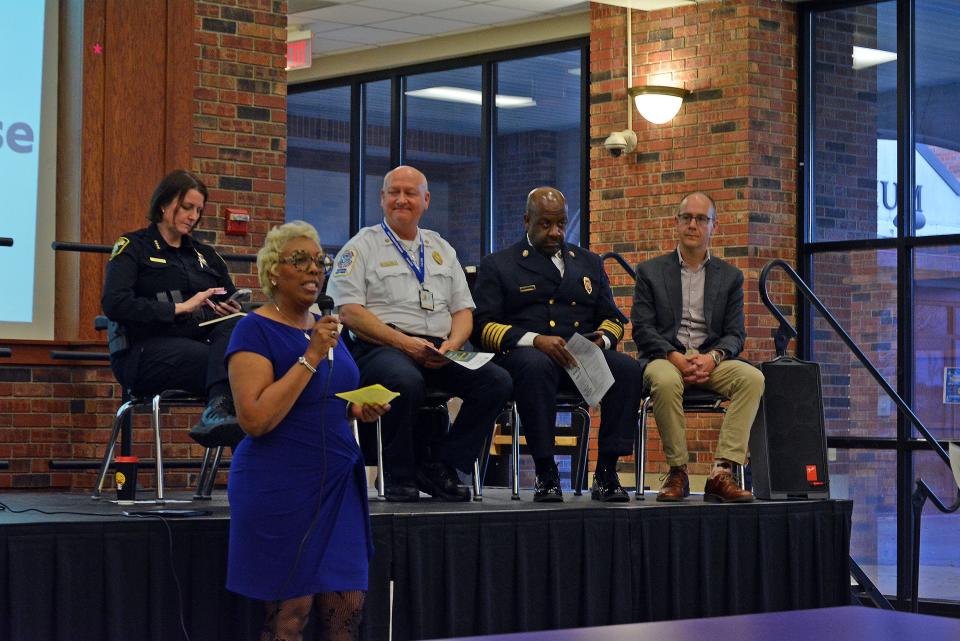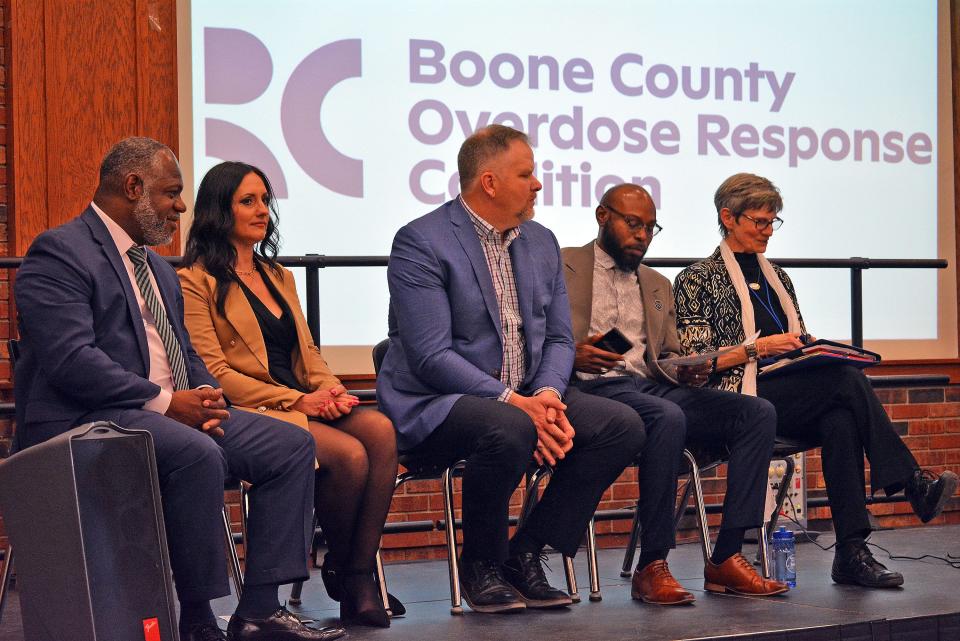'An us problem': How Boone County is working to prevent opioid overdose deaths
A clarion call went out in late 2021 about opioid-related deaths in Columbia and Boone County when the community came together at a town hall meeting.
The results of that meeting eventually led to the creation of the Boone County Overdose Response Coalition. The coalition of 80 collaborative partners in partnership with Columbia/Boone County Public Health and Human Services by December 2022 started monthly trainings and distribution of Narcan, generic name Naloxone, which is used to counteract opioid overdoses.
While work has progressed, more public input is being sought, and so at least a few dozen community members came together Tuesday to get resources, hear ideas and present their own in another town hall meeting at Hickman High School.

The panel discussion and Q&A was facilitated by Chiquita Chanay, University of Missouri Extension education director and community health outreach specialist. Joining the panel were Columbia Police Chief Jill Schlude, Columbia Fire Chief Clayton Farr Jr., Boone County Fire District Chief Scott Olsen, MU Health Care family and addiction medicine physician Lucas Buffaloe, PHHS Health Program Coordinator Heather Harlan, Compass Health Network Director of Substance Use Recovery Services Shannon Crowley-Einspahr, Brightli (parent company of Burrell Behavioral Health) Central Region President Mat Gass, Powerhouse Community Development Executive Director Charles Stephenson and Good Dads Regional Director and reentry advocate D'Markus Thomas-Brown.
Updated statistical data from PHHS notes there were at least 41 opioid overdose deaths in Boone County in 2023. Numbers could change as final cause of death determinations are made by the county medical examiner's office. This is down from a peak in 2022 of 65 deaths. Fifty-one deaths were reported in 2021 and 39 in 2020. Distribution of Naloxone in Boone County has seen at least 110% increase between 2022 and 2023, 728 boxes to 2,524 boxes.
What's being done to prevent opioid-related deaths in Columbia?
Buffaloe has worked to treat people with substance use disorder for nearly a decade and noted that education for medical school students and hospital residents has increased. There are some challenges.
We are not yet at a point where a person "could just go to their doctor, get started immediately on treatment and get connected with resources in their community in their recovery. We are getting better, though," he said. "We have more and more physicians who are prescribing (treatment) medications, who have knowledge and experience of managing substance use disorder and a lot of interest among students and residents in treating this."
When it comes to youth drug and alcohol use, the trend line continues to decline and the number of high school seniors who never have ingested alcohol or used marijuana or illegal drugs is on an upward trend, said Heather Harlan in her presentation.
All first responders have training on Narcan usage, Schlude, Farr and Olsen expressed. Police conduct investigations into overdose deaths to try and find who provided the drugs in the first place with the aim of bringing a prosecution, Schlude said.
Gass and Crowley-Einspahr also are focused on substance use treatment, whether mental health or other treatments. Burrell Behavioral Health regularly reviews its approach to care, and reviews who it employs, so that people who may have similar backgrounds can work together as therapist and client, Gass said.

During the Q&A a good chunk was on harm reduction and dismantling drug use stigma. Part of harm reduction is meeting people where they are in a recovery journey, Crowley-Einspahr said.
"Ways that we try and focus on individuals staying safe is looking at providing preventative information and resources," she said, adding that any street-acquired drug could be laced with fentanyl so Compass can provide fentanyl test strips as a means of preventing overdoses. "... We're really trying to meet individuals where they are. Our focus is on helping them stay safe so they can be successful in their treatment and recovery journey."
Stephenson and Thomas-Brown push for identifying those in neighborhoods who are seen as a resource — the neighborhood matriarch or patriarch even if none of the neighbors are related — because it's someone from within than without delivering the message, training and being that community leader.
Stephenson referenced the collaborative efforts of many smaller organizations, along with city and county officials known as Unity in the Community, which will hold its next monthly "Building Bridges over Barriers Initiative" session 11 a.m. to 1 p.m. March 25 at Hampton Inn and Suites.
Thomas-Brown also encouraged using a trauma-informed lens when addressing opioid usage.
Opioids are "a Columbia problem. A Boone County problem. This isn't just a Black problem or a white problem. This isn't just a Republican or a Democrat problem. This is an us problem and it is going to take us to solve this problem."
Substance use treatment resources available in Columbia area
Those who want to have Narcan on hand can get boxes for free from PHHS 8 a.m. to 5 p.m. Monday through Friday at 1005 W. Worley St.; at Compass Health 8 a.m. to 5 p.m. Monday through Friday at 3501 Berrywood Drive; Behavioral Health Group Columbia Treatment Center 5:30 a.m. to 1:30 p.m. Monday through Friday at 1301 Vandiver Square, Suite Y; and The ROC (Re-Entry Opportunity Center) 9 a.m. to 4 p.m. Monday through Friday at 2108 Paris Road. The ROC also provides fentanyl test strips.

Those seeking substance use disorder treatment in Columbia can contact Behavioral Health Group at 573-449-8338, ext. 524274 or at bhgrecovery.com; Compass Health at 573-449-3953 or compasshealth.org; Burrell Behavioral Health Phoenix Clinic at 573-875-8880; or if in Jefferson City Preferred Family Health Care at 573-632-4321.
For those in a crisis, text or call 988. Youth also can text HOME to 741741. EPICC, Engaging Patients in Care Coordination, has recovery coaches in Cole, Boone and Callaway counties at 1-800-395-2132.
The next Save a Life! Narcan education training and distribution is 5:30 p.m. March 21 at Friendship Place, 110 N. Rollins St. in Centralia. This is the first distribution and training event in Centralia.
How to use Narcan
Narcan is administered similar to other nasal spray medications. Narcan prevents opioids from attaching to brain receptors and negates what already is there. It takes about two to three minutes to work, and its effects wear off in about 30 to 90 minutes.
If there is no change three minutes after administering a dose, it may be necessary to administer a second dose.
Narcan causes near-immediate drug withdrawal symptoms, which is why it is important for a person to be put on their side with their head supported, known as the recovery position.
Rescue breaths may be needed after the first dose of Narcan, and tilting a person's chin up to open the airway may be necessary as well. If 911 is called, let the dispatcher know a dose of Narcan was administered.
To administer Narcan:
Remove the foil backing from the package.
Place the tip of the nozzle into a nostril, making sure your fingers touch the nose.
Push the plunger to administer the entire dose.
More: Youth, community violence at forefront of Unity in the Community organizational team up
Signs of an opioid overdose include:
Breathing will be slow or absent.
Person is not moving.
Lips or fingernails may be blue.
The person may be choking, or you may hear a gurgling sound or snoring.
Cold, clammy skin.
The person will not wake up or does not react to a vigorous sternum rub.
Tiny pupils.
Even if you are not sure a person is having an opioid overdose, it is OK to give a dose of Narcan.
More: 'An overdose nearly every week': A look at fentanyl deaths in Boone County
Charles Dunlap covers local government, community stories and other general subjects for the Tribune. You can reach him at cdunlap@columbiatribune.com or @CD_CDT on Twitter. Subscribe to support vital local journalism.
This article originally appeared on Columbia Daily Tribune: Columbia town hall focuses on opioid overdose prevention strategies

